Unit - 5
Retaining Walls
Q1) What is Retaining wall?
A1)
- A Retaining wall is a shape that holds or keeps soil at the back of it. There are many styles of substances that may be used to create keeping partitions like concrete blocks, poured concrete, handled timbers, rocks or boulders.
- Some are smooth to use, others have a shorter existence span, however all can maintain soil.
- Gravity keeping partitions are partitions that rely upon their personal weight and setback to maintain the soil and are usually shorter in height.
- Allan Block keeping partitions are perfect for this form of wall, due to the fact as they're stacked collectively they lock into region to shape a setback. This setback enables the wall help the strain from the soils at the back of it.
- Reinforced keeping partitions are partitions that use a few form of reinforcement to offer extra energy to the keeping wall shape, as a consequence enhancing its cap potential to maintain the soils at the back of it. For SRW’s (Segmental Retaining Walls), we confer with this reinforcement as geogrid or grid. Geogrid is located among guides of blocks withinside the wall and rolled again into the slope or hillside throughout set up to create a more potent and extra solid soil mass.
- In layman’s terms, the blocks, the geogrid and the bolstered soil mass paintings collectively to make one large, heavy keeping wall shape. Sometimes grid isn't a usable answer on a assignment because of area or different web website online conditions, so opportunity reinforcement substances want to be used – along with no-fines concrete, soil nails or earth anchors. These styles of reinforcement usually require a neighborhood engineer for the layout and a licensed contractor for the set up.
Q2) What is Active Earth pressure?
A2)
It is pressure exerted on retaining wall resulting from slight movement of wall away from filling.
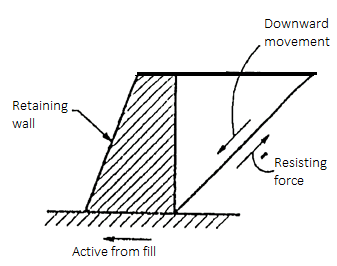
Fig.: Active earth pressure
Q3) What is Passive earth pressure?
A3)
When the movement of the retaining wall is such that the soil tends to horizontally.
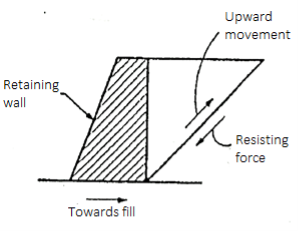
Fig.: Passive earth pressure
Q4) What are the assumptions made by Rankine’s for Earth Pressure?
A4)
Assumptions of the Rankine theory for active earth pressure are as follows:
- The soil mass is semi infinite, homogeneous dry and cohesionless.
- The ground surface is plane which may be horizontal or inclined.
- The back of wall is verticala smooth.
- The wall yields about the base thus satisfies deformation condition for plastic equilibrium.
- The soil element is in state of plastic equilibrium i.e. on verge of failure.
Q5) What is Rigid retaining wall?
A5)
- Retaining partitions are enormously inflexible partitions used for helping soil laterally in order that it may be retained at extraordinary stages on the 2 sides.
- Retaining partitions are systems designed to restrain soil to a slope that it'd now no longer clearly preserve to (normally a steep, near-vertical or vertical slope).
- They are used to sure soils among extraordinary elevations regularly in regions of terrain owning unwanted slopes or in regions in which the panorama wishes to be fashioned significantly and engineered for greater precise functions like hillside farming or roadway overpasses.
- A maintaining wall that keeps soil at the bottom and water at the frontside is known as a seawall or a bulkhead.
Q6) What is flexible retaining wall?
A6)
- Flexible keeping wall is a brand new kind of keeping shape built with the aid of using stacking 3-dimensional community geocells full of soil or gravel.
- The writers analyzed the interplay amongst wall, bolstered layers, and fill the usage of the finite detail software, MARC, and evaluated the pressure distribution of the geocell bendy keeping wall. Field trying out became performed to degree the lateral earth stress of a geocell bendy keeping wall built on an throughway in significant north China's Shanxi Province.
- It became proven that the deformation of bendy keeping wall became appreciably stimulated with the aid of using the width of wall, distance among adjoining bolstered layers, and basis modulus.
- The width of wall affected the pressure degree noticeably. The horizontal displacement of bolstered layers multiplied because the outside load implemented at the fill at the back of the wall multiplied.
- The horizontal pressure of tied bolstered layers advanced in 3 phases: bending, stretching–bending, and stretching because the outside load multiplied. Economic evaluation confirmed that the fee of geocell bendy keeping wall may be decreased with the aid of using 24%, which brings approximately superb financial benefits.
Q7) What are the basic assumptions of Coulomb's Wedge Theory?
A7)
Following are the various basic assumptions of coulomb's wedge theory
- The backfill is dry, non-cohesive (ie. Cohesionless), homogeneous, isotropic, soil (i.e. equal elastic properties in all direction). The backfill is elastically undeformable but breakable
- Backfill possessing both cohesion and internal friction or slip surface
- The failure surface or slip surface is a plane surface which passes through the heel of wall
- Failure is two dimensional. The backfill surface is plane and can be inclined.
- The position and the line of action of the earth pressure or direction of resultant earth pressure are known. The back of the wall can be inclined to the vertical
- The sliding wedge is itself considered as rigid body and the earth pressure is obtained by considering the limiting equilibrium of the sliding wedge as a whole.
Q8) Explain Rankine’s State of Plastic Equilibrium in soils?
A8)
- Plastic equilibrium of soil: When every point of the soil body is on the verge of failure, then a body of soil is said to be in plastic equilibrium. In another word; every point of soil mass at rest condition is brought on the verge of failure by applying tension or compression, then the state so occurred is termed as a general state of plastic equilibrium.
- Rankine's was the only engineer who developed the concepts of plastic equilibrium to solve the stability problems.
- When plastic equilibrium conditions are realised in limited zones of soil, then it is termed as the local state of plastic equilibrium. The development of earth pressure on the retaining wall is part of backfill comes under the plastic equilibrium condition.
- Rankine considered a semi-infinite mass of soil comes under a horizontal surface and a vertical boundary as shown in Fig.
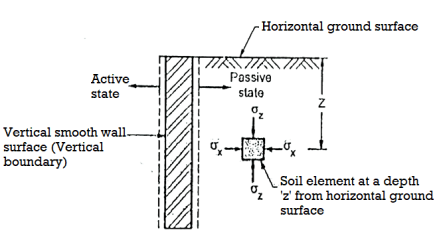
Fig.: A semi-infinite mass of soil bound by a horizontal surface and a vertical boundary
- Rankine assumed the soil mass to be homogenous, cohesionless and dry
- Consider a soil element at a depth 'e' subjected to horizontal stress and vertical stress. There are no shear stresses acting on the horizontal and vertical planes, hence
 and
and  are the principal stresses.
are the principal stresses. - When the soil mass as a whole is stressed in such way that the principal stresses of every point are in the same direction then it set up the network of failure plane. This network of failure plane is called as slip line field as shown in fig. Slip line field is equally inclined to the principal planes. When sufficient deformation of mass take place, only then plastic equilibrium is set up.
Q9) Explain Active and Passive States due to wall movement?
A9)
When Wall Moves Away from Backfill:
- The value of horizontal stress decreases when away from backfill. If the expansion of soil element is more enough, then the value of horizontal stress (
 decreases to a minimum value and state of plastic equilibrium is set up called as active Rankine state as shown in Fig.
decreases to a minimum value and state of plastic equilibrium is set up called as active Rankine state as shown in Fig. - The Mohr's stress circle shows the state of elastic equilibrium as shown in Fig.
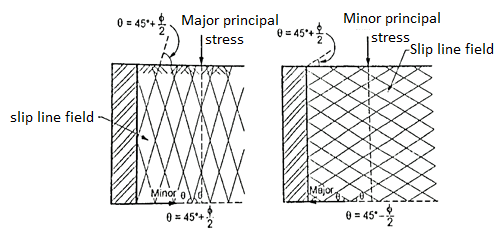
Fig.: Active and passive Rankine state due to wall movement
Active Rankine state
- When the Mohr's stress circle touches the strength line drawn for the soil, then soil mass is active Rankine state.
- Note that plastic equilibrium state is developed due to decrease in the value of horizontal stress (
 ) it means it should be minor principal stress (
) it means it should be minor principal stress ( ); vertical stress (
); vertical stress ( ) and major principal stress (
) and major principal stress ( ), Minor principal stress due to decrease in the value of a, (horizontal stress) and Major principal stress.
), Minor principal stress due to decrease in the value of a, (horizontal stress) and Major principal stress.
When Wall Move towards the Backfill
- In such case, uniform compression is hold in the horizontal direction. There is an increase of horizontal stress (
 ) from its original value, but vertical stress (
) from its original value, but vertical stress ( ) remains constant.
) remains constant. - The diameter of stress circle becomes smaller due to increase of deformation and then reduces to zero. When the horizontal stress becomes more than vertical stress i.e.
 ,then diameter of stress circle increases until a state of plastic equilibrium is reached. At this state, horizontal stress (
,then diameter of stress circle increases until a state of plastic equilibrium is reached. At this state, horizontal stress ( ) is maximum and hence it is a major principal stress (
) is maximum and hence it is a major principal stress ( ) but
) but  , (vertical stress) becomes minor principal stress
, (vertical stress) becomes minor principal stress  .
.
Passive Rankine state
- When Mohr's stress circle drawn with
 , an
, an d touches the strength envelope, then it will be reached with the maximum value of
d touches the strength envelope, then it will be reached with the maximum value of  This state of soil of reaching the maximum value of o, is called as passive Rankine state and pressure so developed is called as passive earth pressure (pp).
This state of soil of reaching the maximum value of o, is called as passive Rankine state and pressure so developed is called as passive earth pressure (pp).
Q10) Explain Earth pressure on retaining wall due to submerged backfill?
A10)
Fig. Shows the retaining wall with backfill submerged by the natural water table saturated water. In such case, the lateral pressure is the sum of the two components.
These two components are as follows,
- Lateral pressure caused by submerged weight (
 ) of the soil, k, y, z and
) of the soil, k, y, z and - Lateral pressure caused by water (
 )
)

Fig.: Submerged backfill
Here at any depth 2 below the horizontal surface active pressure is given by the following expression,
Pa=Ka sz+
sz+ z
z
Where, Pa=active pressure
 s= submerged weight of soil (y)
s= submerged weight of soil (y)
 unit weight of water
unit weight of water
Fig. Shows the active earth pressure distribution diagram at any depth 'z' and at the depth H.
The active pressure at the base of wall, where z H is given by the following expression,
Pa=Ka sH+
sH+ H
H
Q11) Explain Backfill with Uniform Surcharge?
A11)
Fig. Shows the retaining wall with horizontal backfill which is loaded by a uniformly distributed surcharge of intensity "q" by assuming the vertical pressure at any, depth is increased by "q".
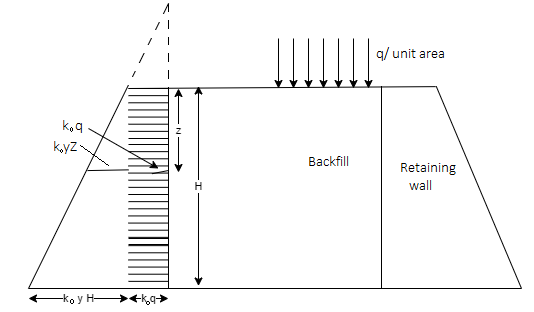
Fig.: Retaining wall with backfill carrying uniform surcharge
∴Lateral active pressure at any depth 'z' is given by the following expression
Pa=Ka z+Kaq ….(at any depth z)
z+Kaq ….(at any depth z)
Where z =H, then, active pressure at the base is given
Pa=Ka H+Kaq .....(at height H from base of wall)
H+Kaq .....(at height H from base of wall)
Q12) Explain Backfill with sloping surface?
A12)
- Rankine's theory can also be applied for backfill with sloping surface at the constant angle
 to the horizontal.
to the horizontal. - To determine the active earth pressure in such case by Rankine's theory, an additional assumption are considered that the vertical stress and lateral pressure are conjugate stresses.
- The active earth pressure at a depth 'z' acting parallel to the slope is given by the following expression:
Pa= Ka γz , ...For sloping surface
, ...For sloping surface
Where, Ka=

Fig.: backfill with sloping surface
For horizontal ground surface;  =0
=0
Ka=
The total active pressure P, for a retaining wall having height 'II' is given by the following expression:
Pa= Ka
Ka H2
H2 
Q13) What is Layered backfill?
A13)
There are two cases for lateral pressure in layered soils which are as follows
- Same angle of shearing resistance
- Different angle of shearing resistance i.e.

(a) Lateral pressure for layered cohesionless soll
1. Same angle of shearing resistance with cohesionless soil layers
- In this case, if
 values for retained materials are considered to be same, then the pressure distribution diagram shows the same values of lateral pressure at same depth for same value of vertical stress (
values for retained materials are considered to be same, then the pressure distribution diagram shows the same values of lateral pressure at same depth for same value of vertical stress ( ) as shown in Fig.
) as shown in Fig.
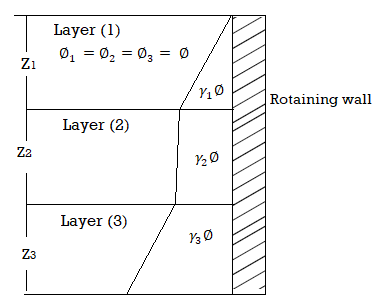
Fig.: Layered soil with same angle of shearing resistance
(2) Different angle of sheering resistance with cohesionless soil layer
- When the upper and lower layers with different values of
 are considered, then the lateral pressure have a lower value for higher angle of friction and higher value of lateral pressure for a smaller angle of friction.
are considered, then the lateral pressure have a lower value for higher angle of friction and higher value of lateral pressure for a smaller angle of friction.
Fig. Shows layered soil with different angle of shearing resistance.
Let consider for the two layers as shown in Fig.
for the two layers as shown in Fig.

Fig.: Layered soil with different angle of shearing resistance
For these two layers, ka1 > ka2, the active pressure are as follows:

Q14) What is tension cracks and depth of tension cracks?
A14)
- Despite the doubtlessly sizeable have an effect on of hysteria cracks on this planet pressures, nearly all of the prevailing techniques both do now no longer account for cracks or deal with them in a simplistic way while managing unsaturated soils.
- The principal goal of this have a look at is to quantify the have an effect on of hysteria crack formation on energetic earth pressures (AEP) in unsaturated backfills. A restriction equilibrium-primarily based totally framework for the dedication of the anxiety crack intensity (TCD) and AEP in unsaturated backfills is proposed.
- A powerful pressure method is hired along side logarithmic spiral failure geometry to evaluate the have an effect on of the interdependence among everyday pressure distributions, suction pressure, and soil tensile power at the formation of hysteria cracks beneathneath consistent go with the drift conditions. The most TCD is explicitly decided with the aid of using comparing a everyday pressure distribution and related tensile stresses mobilized alongside the crucial failure floor in retained backfill, without or with tensile power.
- A parametric have a look at is achieved on a hypothetical marginal backfill to analyze the effect of a anxiety crack on AEP with and with out thinking about the soil tensile power beneathneath exceptional go with the drift rates.
- The consequences imply that the formation of hysteria cracks will drastically boom AEP, at the same time as thinking about a nonzero tensile power as a feature of the matric suction will lower the TCD and AEP.
- Upon comparison, it's miles proven that conventional earth strain theories might also additionally drastically underestimate or overestimate TCD in unsaturated backfills.
- The proposed method provides a beneficial device for forensic research of failed systems and figuring out the intensity of cracks in current preserving earth systems which can be to be rehabilitated.
Q15) Explain Critical Depth of Excavation?
A15)
- Exploration, in general, should be carried out to a depth upto which the increase in pressure due to structural loading is likely to cause perceptible settlement or shear failure.
- Such a depth, known as the significant depth, depends upon the type of structure, its weight, size, shape and disposition of the loaded areas, and the soil profile and its properties.
- It is generally safe to assume the significant depth upto a level at which the net increase in vertical pressure becomes less than 10% of the initial overburden pressure.
- Alternatively, a pressure bulb bounded by an isobar of one-fifth or one-tenth of the surface loading intensity is sometimes assumed to define the minimum depth of exploration.
- This depth may be assumed to be equal to one-and a half to two times the width (smaller lateral dimension) of the loaded area.
Q16) Explain Rebhan’s Graphical solution?
A16)
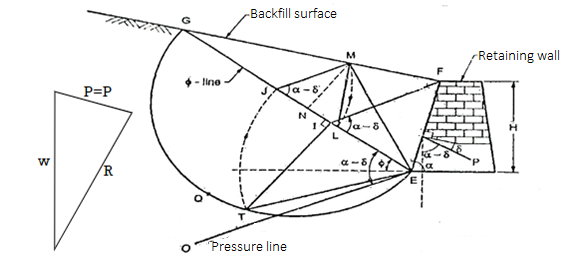
Graphical method by poncelet construction based on Rebhann’s principles
- In 1871, Rebhann's represented a graphical method to determine the total active pressure (Pa) based on Coulomb's theory on a rough wall with a cohesionless, homogenous and inclined backfill as shown in Fig.
- Fig.shows poncelet construction for non-cohesive soils or cohesionless soils (C = 0) based on the principles made by Rebhann.
Procedure of graphical method:
Following is the procedure of construction to find out the active earth pressure by graphical method refer Fig.
- Draw a retaining wall to a suitable scale and measure the backfill surface angle for required position as shown in Fig.
- Draw a -line EG such that it intersect the backfill surface at G.
- Draw a semi-circle BQG by taking diameter as EG.
- Draw the pressure line 'EO' at an angle of (a-5) with respect to o-line.
- Draw FI parallel to pressure line 'EO'.
- Draw a perpendicular to EG at I such that it cut the semi-circle at T.
- With centre E and radius ET, draw an are such that it cut EG at J.
- Draw JM parallel to FI
- Now EM is a rupture line
- Taking as a centre and IM as the radius draw at a such thar EG at L
After this construction from step 1 to 10, it shows the  LIM. Area of
LIM. Area of  LIM in its natural unirs multiplied by the unit weight of the soil (
LIM in its natural unirs multiplied by the unit weight of the soil ( ) gives the active earth pressure (Pa) as follows:
) gives the active earth pressure (Pa) as follows:
Pa=Area of triangle LJM= *JM*MN
*JM*MN
Where,  =unit wt of the soil
=unit wt of the soil
JM length of a triangle LJM
MN=height of  LJM
LJM
Pa=Active earth pressure
Q17) Explain Culmann’s Graphical solution?
A17)
- Culmann's graphical method is rather general method than Rebhann's method. This method is same as the trial wedge method. The force triangle or force polygon can directly be constructed on o-line EG considering EG as a load line.
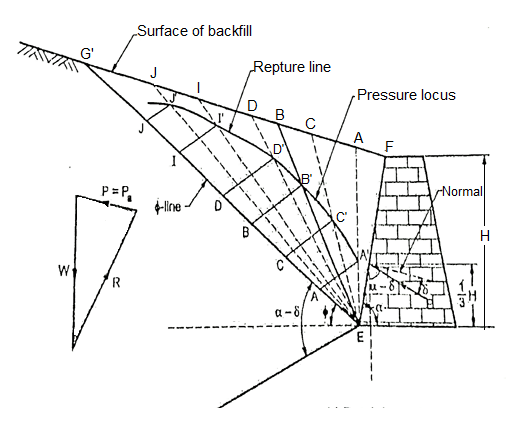
Fig.: Culmann’s graphical method for determining active earth pressure
- This method can be used to evaluate the coulomb's earth pressure fr ground sa face of any configuration, different types of surcharges and layered backfills.
- Fig. Shows the Culmann's graphical method of determine active earth pressure (P) for non-cohesive soils or cohessionless soils (i.e. C= 0)
Graphical construction procedure;
- Various steps involved in the procedure are as follows:
- EF it a retaining wall as shown in Fig. 5 in 1(a) drawn to a suitable scale.
- Draw -line EG at an angle with respect to horizontal.
- Mark on EG, the distances EA, EC, ED, EL, EJ etc to a suitable scale representing the weight of wedges EFA, EFC, EFD, EFI, EFI etc respectively.
- Draw lines parallel to pressure line ET from the points A, C, D, I J such that it intersects assumed rupture line EA, EC, ED, EI, EJ at points A,C,D,1,J respectively.
- Then point A', C, D, I', J' are joined by a smooth curve representing the pressure locus.
- Select point B' on the pressure locus in such way that the tangent to the curve at this point parallel to line EG
- Draw B'B parallel to the pressure line ET. The magnitude of B'B" itself in its natural units gives the active earth pressure (Pa)
- Points E and B' are joined and extended further so as to meet the surface of backfill at B Then EB is the rupture line.
- Note that, for the plane backfill surface, the point of application of active earth pressure (Pa) is at a height 1/3 of from the base of retaining wall.
Q18) Compute the active earth pressure at a depth of 4.5m in a sand whose angle of friction is 37 degree and density of 15.60KN/m3 in dry state.
A18)
H = 4.5m,  = 37% ,
= 37% ,
To compute the active earth pressure at a depth H in dry state
We know,
From Rankine's theory, active earth pressure (p) at a depth His given by:
Pa=Ka ….(1)
….(1)
Where Ka=coefficient of active earth pressure=
∴Ka= =0.248
=0.248
Substituting Ka=0.248 in equation 1 we get,
Pa=0.248×15.60×4.5
∴Pa=17.4kN/m3
Q19) A smooth vertical wall retains a level surface with  to a depth of 8m. Compute the total active pressure in dry condition and when water table rises to the GL Assume
to a depth of 8m. Compute the total active pressure in dry condition and when water table rises to the GL Assume
A19)
H=depth=8m



To compute the total active pressure Pa in dry condition:
Ka=Coefficient of active earth pressure=
∴Total active earth pressure in dry condition (Pa)
=Ka =1/3×18×8
=1/3×18×8
Pa=48KN/m3
To compute the total active earth pressure when water table rises to the GL(i.e submerged soil)

∴Total active earth pressure(Pa)
=
∴Pa=112KN/m2